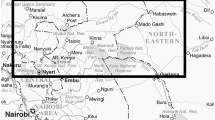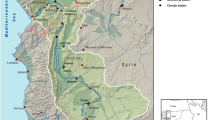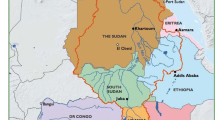Abstract
The current location of the border between Lebanon and Palestine, today's Israel, is a product of various competing forces. The Zionist Organization aspired to include the entire Galilee region up to the lower reaches of the Litani River (also known as the Kassimiyah River) within Palestine. The river itself was the desired northern border of the country. The Zionists supported their position by employing instrumental arguments that were largely related to the availability of water resources. On the other hand, residents of the upper Galilee, today's southern Lebanon, demanded that they be included with Lebanon. They used their trade links with Beirut, and cultural and familial ties with other parts of Lebanon to support their position. These instrumental and expressive arguments appear to have assisted in the demarcation of the border between Lebanon and Palestine. Currently, access to the water resources, not necessarily control over them, is likely to influence negotiations between Israel and Lebanon over the future of the Israeli-occupied ‘security zone’ in southern Lebanon.
Similar content being viewed by others
References
Amery, H.A.: Water Diversion Theory from Lebanon: Public Participation for Peace. In Amery, H.A. and A.T. Wolf (eds.), Hydrogeography of the Middle East at Peace. University of Texas Press, Austin (Forthcoming).
Amery, H.A: Water Security as a Factor in Arab-Israeli Wars and Emerging Peace. Studies in Conflict and Terrorism. 20: 95–104 (1997).
Amery, H.A.: The Litani River of Lebanon. Geographical Review July. 83: 229–237 (1993a).
Amery, H.A.: Israeli Designs on Lebanon's Water. Middle East International (London). 458: 18–19 (1993b).
Amery, H.A.; Kubursi, A.A.: ‘The Litani River: The Case Against Inter-basin Transfer.’ In: Collings D. (ed), Peace For Lebanon: From War to Reconstruction, Boulder, Colorado: Lynne Rienner 1994.
Berger, E.: The Covenant and The Sword. London, Routledge and Kegan Paul 1965.
Barel, T.: Lebanon: From where we Don't Count our Dead. Ha'aretz 27 December 1996. (Published in English in Middle East International 10 January, 1997, p.21).
Bargouthi,-al, M.: Israeli Interests in the Water of Palestine and Nearby Arab States. (in Arabic) Amman, Galilee Publishing Centre 1986.
Beschorner, N.: Water and Instability in the Middle East. London, International Institute for Strategic Studies, Adelphi paper 273. 1992.
Biger, Gideon: River and Lake Boundaries in Israel. In: Schofield C.H., Schofield R.N. (eds.), The Middle East and North Africa. World Bounadries Volume 2. Routledge, London and New York. 99–109, 1994.
Biger, Gideon: The Awali Line: A Historical Zionist Line? Haaretz [in Hebrew]. 23 August 1983: 10.
Bulloch, J.; Darwish, A.: Water Wars: Coming Conflicts in the Middle East. London, Victor Gollancz. 1993.
Brawer, Moshe: The Geographical Background of the Jordan Water Dispute. in Essays in Political Geography. Fisher (ed) London, Butler and Turner. 1968: pp.225–242.
Caplan, Neil: Futile Diplomacy: Arab-Zionist Negotiations and the End of the Mandate, Vol. II. London: Frank Cass 1986.
Chomsky, Noam: The Fateful Triangle: The United States, Israel and the Palestinians. Montreal, Quebec: Black Rose Books 1984.
Cohen S.B.: The Geopolitics of Israel's Border Question. Boulder: Westview Press, 1986.
Dan, U.; Eisenberg, D.: It's No-win in Lebanon. Jerusalem Post (internet edition). 12 June, 1997.
Department of State: Israel-Lebanon Armistice Line. No. 75, February 15. International Boundary Study, Office of the Geographer 1967.
Economist, The: Generals and Politics: The Increasing Lonliness of being Turkey. 19 July. 21–23 (1997).
Encyclopedia Judaica: Jerusalem, Keter Publishing House 1972.
Foreign Relations of the United States: The Paris Peace Conference, 1919. Washington G.P.O., (Vol. 2) 1947
Friedman, T.L.: From Beirut to Jerusalem. New York, Ferrar Strus Giroux 1989.
Frischwasser-Ra'anan, H.F.: The Frontiers of a Nation. London: The Batchworth Press 1955.
Galnoor, I.: Territorial Partition of Palestine: the 1937 decision. Political Geography Quarterly. 10 (4): 382–404 (1991).
Garfinkle, A.: War, Water and Negotiation in the Middle East: Case of the Palestine-Syrian Border, 1916–1923. Tel Aviv, Moshe Dayan Center for Middle Eastern and African Studies, Tel Aviv University. 1994.
Hagopian, E.C.: Redrawing the Map in the Middle East: Phalangist Lebanon and Zionist Israel. Arab Studies Quarterly. Fall, 5(4): 321–336 (Fall 1983).
Hof, F.C.: Galilee Divided: The Israel-Lebanon Frontier, 1916–1984. Boulder, Colo.: Westview Press 1985.
Holubeshen, M., H.A. Amery, and J. Starr: Annotated Bibliography on Water in the Middle East. Toronto: Centre for International Studies, University of Toronto. 1995.
Israel Office of Information: Israel's Struggle for Peace. New York, Israel Office of Information 1960.
al-Kayed, M.: The Idea of water and (its effects on) the borders of the Zionist State. al-Iktisadi Samed. (in Arabic) 14, 100–128 (1992)
Khalifeh, Issam K.: The Southern Borders of Lebanon, 1908-1936, (in Arabic). Beirut: no publisher. 1985.
Kimmerling, Baruch: Zionism and Territory: The Socio-territorial Dimensions of Zionist Politics. Berkeley, California: Institute of International Studies 1983.
Kirk, George: The Middle East, 1945-1950. London. 1954
Kliot, N: Water Resources and Conflict in the Middle East. London and New York: Routledge. 1994.
Lorch, Natanel: The edge of the Sword: Israel's War of Independence, 1947–9. New York: G.P. Putnam's Sons 1961.
Lowdermilk, W.C.: Palestine, Land of Promise. London: Victor Gollancz 1944.
Lowi, M.R.: Water and Power: The Politics of a scarce resource in the Jordan River basin. Cambridge: Cambridge University Press 1993.
Meinertzhagen, Richard: Middle East Diary, 1917-1956. London: Cresset 1959.
Nevakivi, J.: Britain, France and the Arab Middle East 1914-1920. London, Athlone Press and Oxford University Press 1969.
Paddison, R: The Fragmented State: The Political Geography of Power. Oxford: Basil Blackwell 1983.
Rayiss, al-, Fayez H.: The Seven Southern Villages. (in Arabic). Beirut: Muassat al-Wafa' 1985.
Sachar, Howard M.: The Emergence of the Middle East: 1914-1924. New York: Alfred A. Knopf 1969.
Sachar, Howard M.: A History of Israel: From the Rise of Zionism to Our Time. New York: Alfred A. Knopf 1979.
Saleh, H.A.: The Water War Between the Arabs and Israel. (in Arabic) Arab Affairs. (55) 55–68 (September 1988).
Schweizer, Peter: The Spigot Strategy. New York Times. 11November, 1990.
Saliba, S.N.: The Jordan River Dispute. The Hague, Martinus Nijhoff. 1968.
Salibi, Kamal: The Modern History of Lebanon. New York, Caravan Books 1965.
Tyler, W.P.N.: The Huleh Lands Issue in Mandatory Palestine, 1920– 1934. Middle East Studies. 27: 34–373 (1991).
Yusuf, M.D. The Zionists and the Process of Defining the borders of Palestine, 1915-1923. Jornal of South Asian and Middle Eastern Studies. 15, 18–39 (1991).
Weisgal, M.W. (ed.): The Letters and Papers of Chaim Weizmann. (Vol. 9) Jerusalem: Israel University Press 1977.
Weizmann, Chaim: Trial and Error: The Autobiography of Chaim Weizmann. New York: Harper and Brothers 1949.
World Resources Institute: World Resources 1994-95. New York, Oxford University Press 1993.
Zamir, Meir: Emile Edde and the Territorial Integrity of Lebanon. Middle East Studies. 14(2): 232–233 (May 1978).




